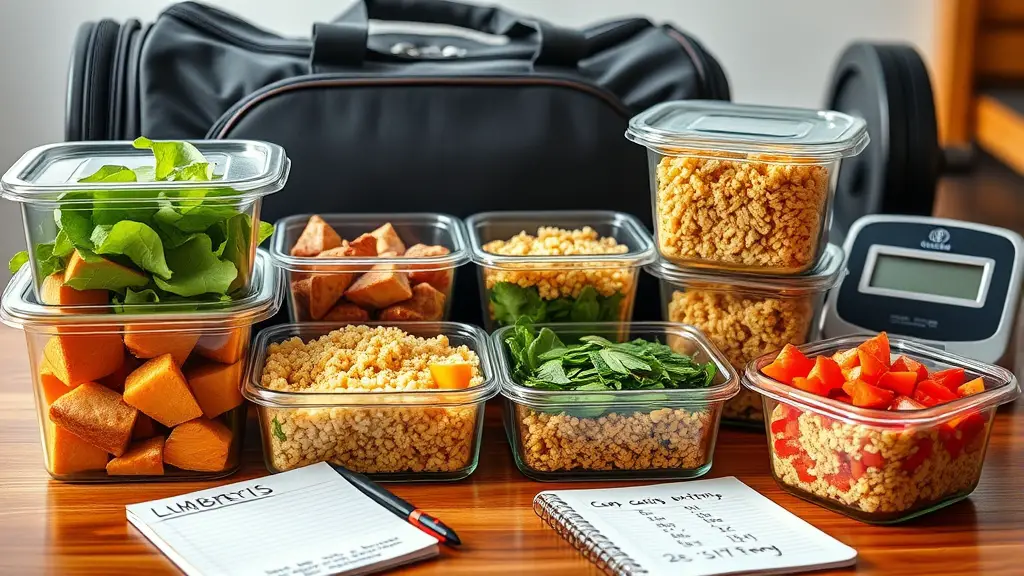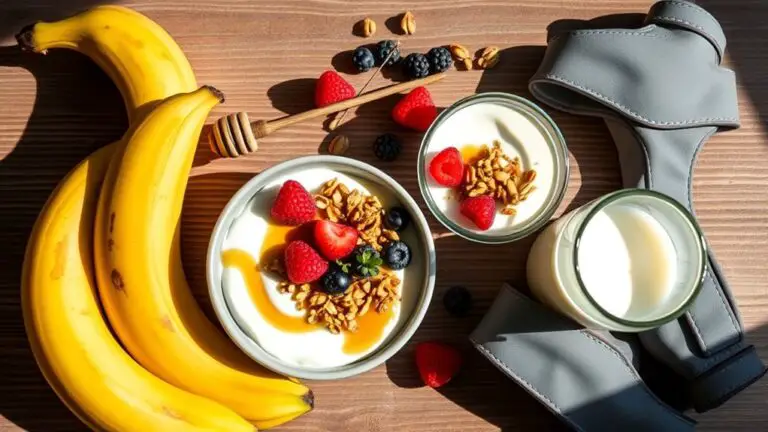How to Use Carb Cycling for Gym Performance

To enhance your gym performance with carb cycling, alternate between high-carb days and low-carb days based on your workout intensity. On high-carb days, consume nutrient-dense foods like oatmeal and quinoa to replenish glycogen stores. Low-carb days focus on proteins and healthy fats to promote fat utilization while preserving muscle mass. Monitor your energy levels during workouts and adjust your schedule as needed to optimize results. You’ll discover more insights on maximizing your carb cycling approach.
Understanding Carb Cycling: The Basics

While you might have heard about various dieting strategies, carb cycling stands out as a flexible approach designed to enhance gym performance. Fundamentally, carb cycling involves alternating between high-carb and low-carb days, which can help optimize energy regulation for workouts. On high-carb days, you consume more carbohydrates to replenish glycogen stores, providing your body with the necessary energy for intense training sessions. Conversely, on low-carb days, the reduced intake encourages your body to tap into fat stores for energy, aiding in fat loss.
The key to effective carb cycling lies in understanding your individual energy needs and workout intensity. By adjusting your carbohydrate intake based on your training schedule, you can maximize performance while still promoting fat loss. This method not only allows for greater flexibility in meal planning but also supports sustained energy levels, making it a practical option for those aiming to improve their gym results.
Benefits of Carb Cycling for Gym Performance
When you incorporate carb cycling into your routine, you can experience a range of benefits that directly enhance your gym performance. One of the primary advantages is improved energy management. By strategically timing your carbohydrate intake, you can guarantee that your body has the fuel it needs during high-intensity workouts. Research indicates that athletes who practice carb cycling often report increased endurance and reduced fatigue.
Additionally, carb cycling can lead to performance enhancement through better recovery. On high-carb days, your glycogen stores are replenished, allowing for quicker recovery times between sessions. This means you can hit the gym harder and more frequently, maximizing your results.
Moreover, carb cycling may help maintain lean muscle mass while promoting fat loss, making your workouts more effective. By understanding how to optimize your carb intake, you can elevate your performance and achieve your fitness goals more efficiently.
How to Determine Your Carb Cycling Schedule

To create an effective carb cycling schedule, start by evaluating your activity levels throughout the week. This will help you calculate your daily carb needs based on your workouts and recovery days. Once you have that information, you can plan your high and low carb days to optimize performance and recovery.
Assess Your Activity Levels
How can you effectively tailor your carb cycling schedule to match your activity levels? Start with an activity assessment to gauge your daily energy expenditure. Track your workouts, daily movements, and any high-intensity activities. This helps you identify high-carb days for intense training and low-carb days for rest or light activity.
For example, if you’re weightlifting three times a week, plan higher carb intake on those days to fuel performance and recovery. Conversely, if you have a rest day, reduce your carb intake to optimize fat utilization. By aligning your carb intake with your activity levels, you can enhance energy availability and improve gym performance, ensuring you’re fueled appropriately for each workout.
Calculate Daily Carb Needs
Determining your daily carbohydrate needs is key to effectively implementing a carb cycling strategy. Start by calculating your intake based on your total daily energy expenditure (TDEE). This involves estimating your basal metabolic rate (BMR) and factoring in your activity level. Once you have your TDEE, you’ll want to set your carb intake as a percentage of your overall calories. For example, if you’re looking to maintain muscle during high-intensity workouts, you might use ratios like 50-60% carbs on high days and 20-30% on low days. Adjust these estimates based on your body’s response and performance. Remember, fine-tuning your carb ratios can greatly enhance your gym performance while optimizing fat loss.
Plan High and Low Days
While establishing your carb cycling schedule, it’s essential to align your high and low days with your workout regimen and recovery needs. Typically, you’ll want to schedule high days around intense workout sessions to fuel your performance. High day strategies include consuming complex carbohydrates like brown rice and sweet potatoes, which provide sustained energy. Conversely, on low days, when your training is lighter or focused on recovery, you can reduce your carb intake, emphasizing protein and healthy fats. Low day recipes might include salads with lean protein or omelets with vegetables. By strategically planning these days, you’ll optimize your energy levels, enhance muscle recovery, and support your overall gym performance effectively.
High-Carb vs. Low-Carb Days: What to Eat

When planning your carb cycling strategy, understanding what to eat on high-carb versus low-carb days is crucial for maximizing gym performance. On high-carb days, focus on nutrient-dense foods to replenish glycogen stores and fuel your workouts. Include high carb snacks like:
- Oatmeal topped with fruit
- Quinoa salads with lean protein
- Whole grain pasta with vegetables
On low-carb days, prioritize proteins and healthy fats to promote fat loss while maintaining muscle mass. Opt for low carb meals such as:
- Grilled chicken with steamed broccoli
- Salmon with avocado
- Eggs with spinach and cheese
Balancing your intake according to these guidelines will help you optimize energy levels and muscle recovery. Be certain to adjust portion sizes based on your activity level and personal goals to guarantee you’re getting the right nutrients when you need them most.
Timing Your Carbs for Optimal Energy
To maximize gym performance, it’s not just about what you eat, but also when you eat your carbs. Carb timing plays an essential role in ensuring you have the energy spikes necessary for high workout intensity. Aim to consume complex carbs about 1-3 hours before your workout. This gives your body time to digest and convert them into usable energy.
During intense training sessions, your muscle glycogen depletes quickly, so consider having quick-digesting carbs immediately post-workout to replenish your stores. This can enhance recovery and subsequent performance.
Meal frequency also matters; spreading your carb intake throughout the day can maintain stable energy levels, preventing crashes that might hinder your workouts. By strategically timing your carbs around your training schedule, you’ll optimize performance and maximize the benefits of your carb cycling approach.
Monitoring Progress and Adjusting Your Plan

As you begin your carb cycling journey, monitoring your progress is essential for ensuring the approach aligns with your fitness goals. Regular progress tracking helps you identify what’s working and what isn’t, allowing for timely plan adjustments. Here are three key areas to focus on:
- Body Measurements: Track changes in weight, muscle mass, and body fat percentage to gauge your overall progress.
- Strength Performance: Keep a log of your workouts, noting increases in weights lifted or improvements in endurance, which indicate effective carb cycling.
- Energy Levels: Pay attention to how your energy fluctuates during workouts; consistent fatigue may signal a need for more carbs on certain days.
Common Mistakes to Avoid in Carb Cycling
When you start carb cycling, it’s easy to make mistakes that could hinder your progress. Ignoring your individual needs, overcomplicating your meal plans, and neglecting hydration can all lead to suboptimal results. By being mindful of these common pitfalls, you can better tailor your approach and enhance your gym performance.
Ignoring Individual Needs
While many people plunge into carb cycling with enthusiasm, they often overlook the importance of individual needs, which can lead to ineffective results or even burnout. Understanding your unique requirements is essential. Here are a few aspects to take into account:
- Individual preferences: Your food choices and tastes matter; ignoring them can make the diet feel restrictive.
- Activity levels: Adjust your carb intake based on how hard you train each day. Higher activity days may require more carbs.
- Body response: Monitor how your body reacts to carb cycling and make personalized adjustments to optimize performance and recovery.
Overcomplicating Meal Plans
Overcomplicating meal plans is a common pitfall for those trying carb cycling, often stemming from a desire to maximize results. Instead of creating elaborate menus, focus on meal simplicity and nutrition balance. Here’s a simple comparison of meal planning approaches:
| Complicated Meal Plan | Simple Meal Plan |
|---|---|
| Multiple ingredients for each meal | 3-4 core ingredients |
| Frequent meal prep sessions | Batch cooking once a week |
| Tracking every macro meticulously | General guidance on carbs/proteins |
Neglecting Hydration Levels
Though you might be focused on adjusting your carb intake, neglecting hydration can greatly hinder your gym performance. Hydration is essential for peak function, especially when carb cycling. When you’re dehydrated, you may experience several negative effects, including:
- Decreased endurance: Your stamina can suffer, making workouts feel harder than they should.
- Impaired recovery: Without proper hydration, muscle recovery slows, which can stall your progress.
- Reduced strength: Even slight dehydration can lead to a drop in strength, affecting your lifting potential.
Staying mindful of hydration importance is critical for maximizing the benefits of your carb cycling plan. Aim to drink enough water daily, adjusting based on your activity level, to avoid the dehydration effects that can sabotage your hard work in the gym.
Frequently Asked Questions
Can Carb Cycling Help With Weight Loss and Muscle Gain Simultaneously?
You might say carb cycling’s a clever way to juggle your goals. By alternating high and low carb days, you can create a caloric deficit for weight loss while still supporting muscle recovery. This approach allows your body to burn fat while providing the nutrients needed for muscle growth. Research suggests that with careful planning, you can indeed achieve both weight loss and muscle gain simultaneously, making it an appealing strategy for fitness enthusiasts.
Is Carb Cycling Suitable for Beginners in Fitness?
Carb cycling can be suitable for beginners, but it’s essential to understand the basics first. Start by learning how to adjust your carbohydrate intake based on your activity levels. A practical beginner tip is to begin with a simple structure, like high-carb days on workout days and low-carb days on rest days. This approach can help you adapt to the dietary changes without overwhelming yourself, making it easier to achieve your fitness goals.
How Long Should I Follow a Carb Cycling Plan?
When considering carb cycling duration, it’s best to start with a short-term plan of 4-6 weeks. This allows you to assess how your body responds without committing long-term. After that, you can evaluate the long-term effects on your energy and performance. If you find it beneficial, you might continue for another cycle, but don’t forget to listen to your body and adjust as needed to avoid potential burnout or nutrient deficiencies.
Are There Any Supplements to Enhance Carb Cycling Results?
Like a finely-tuned orchestra, your body needs the right supplements to harmonize with carb cycling. Pre-workout formulas can boost your energy and focus, enhancing performance during training. Meanwhile, recovery supplements, such as branched-chain amino acids (BCAAs) and creatine, aid muscle repair and optimize glycogen storage. Combining these with your carb cycling strategy can amplify results, ensuring you’re not just hitting notes, but creating a symphony of strength and endurance in the gym.
What Are the Signs of Inadequate Carb Intake During Cycling?
If you’re experiencing low energy levels during your carb cycling, that’s a key sign of inadequate intake. You might notice a performance decline in your workouts, struggling to lift weights or maintain endurance. Other signs include increased fatigue, mood swings, and cravings for carbs. To optimize your cycling, pay attention to how your body feels, and consider adjusting your carb intake on low-energy days to support your performance effectively.





